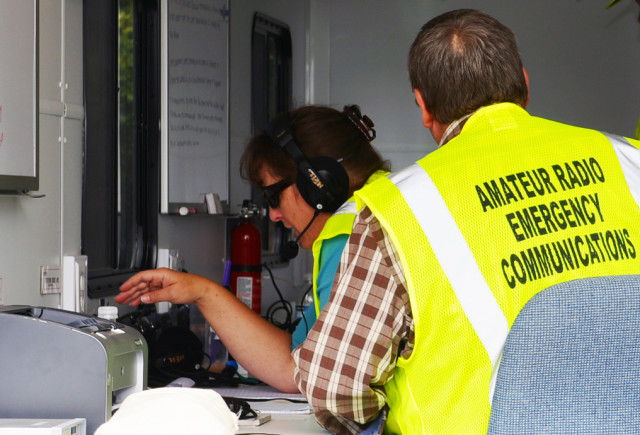Emergency Procedures
Imagine that you find yourself in a disaster-affected area; an earthquake, flood or a period of civil unrest. You desperately need to find out if your grandparents, who live in country, are OK, but the power lines are down and your cell-phone is dead. So you grab your amateur radio, a roll of hookup wire, an old car battery from the garage and a wrench and you dash out the back door. There is a tall tree near the fence: You tie one end of the wire to the wrench and hurl it over the highest branch. You attach the other end to the antenna jack on your radio. You connect up the car battery, but nothing happens; it is totally flat. You run inside looking for batteries. Until today you never realised how important emergency power is. Most devices just use one or two small batteries and you don't have anything to connect eight or more up to get enough juice to power the radio. Then, in the tool shed, you find a cordless drill. It has an 18 volt battery - which is flat - but in the box there is a spare battery, which tests out ok! Back at the radio, you strip some hookup wire with your teeth (not recommended) and connect the battery up. Positive to positive, negative to negative, right. You tune around the band and surprising find a lot of on-air activity. Amateur radio operators from all around are doing what they can to help in the disaster. You call one station to ask him how you can contact your grandparents. The operator says to call "Jim", who is in that area: He is 25 kilohertz up the band. You tune up, but have to wait, while Jim handles other important traffic. When you call him and give the address, he says he will contact a mate, who is mobile in that area, on another rig. A bit later, Jim calls you back. "I'm going to patch you in to the VHF - standby". Then you hear: "Hello, hello, do I speak in here?" It is your grandmother! They had a rough night, not being able to get in touch, but they are all OK now... What a relief. When you finish up you have time to reflect on what just happened: Amazing that it worked at all, really. It makes you think about how you could have better prepared for the disaster situation...
Introduction
Amateur radio shortwave communication does not depend on telecommunication service providers, national carriers, cell-phone towers, radio and television broadcasters, telephone exchanges or even the Internet. All these services can fail, and often do in times of natural disaster. Indeed, when all else fails with emergency communications, it is often Amateur Radio operators who are the first to respond with news from a disaster-affected area. Why is that? Because Amateur Radio operators provide and maintain their own equipment and have the skills to setup and use it effectively even when there is no power or commercial infrastructure available. How is this possible? Many amateur radio contests, sporting activities and emergency groups encourage individual operators to develop skills in portable shortwave operations, enabling them to communicate virtually all around the world using battery or solar powered equipment and makeshift antennas.
As well as being able to setup and use your radio equipment in an emergency situation, there are also special operating procedures designed to be the most effective way of calling for help. There are two procedures: The urgency call (PAN), to be used only in an emergency situation, and the distress call (MAYDAY) to be used only in a life and death situation. Never use these calls unless you are in a real emergency situation. There are serious penalties for making hoax emergency calls.
Here is the procedure: Say the word PAN or MAYDAY 3 times. Say your Call Sign 3 times. Give your location. State your emergency situation. Repeat the call for as long as possible or until someone responds. Keep calling if no one responds, assume someone will be listening and will call the authorities.
Urgency Call - Emergency situation
"PAN PAN PAN, this is <VK3FOWL>, <VK3FOWL>, <VK3FOWL>. <Horan's tack, 4km South of Mount Hickey>. <1 Male hiker with broken leg>.
Distress Call - Life and Death situation
"MAYDAY MAYDAY MAYDAY, this is <VK3FOWL>, <VK3FOWL>, <VK3FOWL>. <Stapylton's camp, Grampians>. <8 campers surrounded by bushfires>.
Preparation
You will need:
- A table and chairs
- A microphone (no radio attached)
- Topographical Maps (optional)
- Pens and paper
Activity
- In a round-table group, each member makes up their own call sign, their location and an emergency situation. (Note: Try to be serious)
- Pass the microphone around the table. Students take turns to make an emergency or distress call. Others write down the details and give a critique.
- The use of map grid references or latitude/longitude is optional, but educational if you have time.

Homework
- Discuss with family members what you would do in an emergency situation.
- Have a look at the Home Emergency Plan resource.

